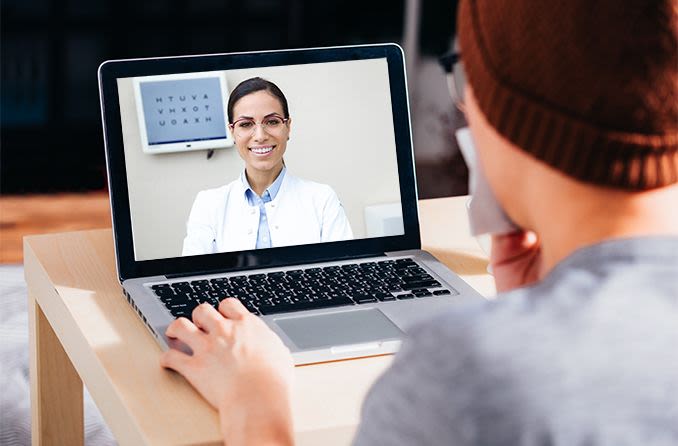Eye doctors incorporate telemedicine as a response to COVID-19

Eye care providers using teleconsultations to assess patients
During the COVID-19 pandemic, some eye doctors are seeing patients via virtual visits while their offices are closed or limited for routine eye care, such as eye exams.
This means that you may be able to video consult with your eye doctor to find out if the bump on your eyelid is a stye or chalazion. But certain aspects of eye care will still require a clinic visit.
The partial shift to telemedicine is helping control the spread of COVID-19 in several ways, and you may be able to take advantage of this growing use of technology.
What is telemedicine?
The Ministry of Health and Family Welfare (MoHFW) defines telemedicine as a delivery method of health care services at a distance by health care providers.
It involves the use of communication technologies that assist with “diagnosis, treatment and prevention of disease and injuries, research and evaluation, and for the continuing education of health care providers,” the MoHFW states.
“Virtual clinic visits,” or teleconsultations conducted by phone or video call, tend to fall under the scope of telemedicine.
In August 2020, the Central Government Health Scheme (CGHS) began offering teleconsultations with specialists through the MoHFW platform e-Sanjeevani.
Eye facilities were included, along with medicine, orthopaedics and ENT.
The advantages of teleconsultations
It’s easy to see why virtual appointments with eye care professionals could be useful during a global pandemic.
A teleconsultation gives the patient a chance to speak with — and often see — an eye doctor without exposing themselves or the office’s medical staff to the coronavirus.
This is especially useful when a particular community experiences high rates of COVID-19 infection.
“Telemedicine has helped us a lot in decreasing the need for a physical consult thus avoiding the risk of cross infection for the patient and the health care professionals,” Dr. Jagadesh Reddy told Express Healthcare in July 2020.
Reddy is the Head of Cataract and Refractive Service at L V Prasad Eye Institute in Hyderabad. He emphasises that teleconsultations offer a contactless gateway to more comprehensive, in-office exams — if needed.
“Telemedicine has also helped to identify patients who need a physical consult for evaluation of cataract,” Reddy said. “After surgery the number of physical visits to the clinic is restricted to only one visit. The other consultations are done through telemedicine.”
Telemedicine can also provide eye care to areas with little or no access to eye doctors.
A 2019 report by the World Health Organization (WHO) adds that virtual health measures have attracted significant interest from health communities, particularly in areas “where mobile communication has opened a new channel for overcoming geographical inaccessibility of health care.”
In the midst of the COVID-19 pandemic, that interest has grown.
Telemedicine isn’t without limitations
While virtual care has been important during the COVID-19 pandemic, it has its drawbacks.
Many might argue that a teleconsultation’s biggest limitation is the same concept that makes it appealing in the first place — a lack of physical presence.
While telemedicine policies vary based on the eye care professional or clinic, eye doctors can feel limited by these appointments without a view inside the eye, or the use of specific instruments.
For this reason, many consultations are used as an “evaluation,” where eye doctors search for the signs of more emergent problems that would require an in-person exam.
The eye care provider will use their best judgment to determine whether the patient needs to be referred to a brick-and-mortar office or not.
From a personal perspective, telemedicine limits the relationship between patient and doctor.
It can be more difficult to personally connect with a patient and pick up on subtle verbal and non-verbal cues during the examination, as the MoHFW notes.
Live video teleconsultations also require a fair amount of internet bandwidth, as do other activities that utilise live video.
High-speed internet isn’t always available, which could affect the implementation of telemedicine in individual households or entire areas.
These areas may rely more heavily on text-message or phone consultations, in place of live video, which can present additional challenges.
Using teleconsultations on a case-by-case basis
Groups like the MoHFW and WHO have released extensive guidelines to help medical practitioners best utilise telemedicine.
The guidelines cover tools, terminology, information gathering, how to prescribe medicine and numerous other facets of the practice.
The coronavirus pandemic isn’t the country’s first meeting with telemedicine. India, along with many other countries, have been implementing the procedures into practice for years, even among eye care providers.
Two years before COVID-19 was discovered, Dr. R. Kim, the Chief Medical Officer of Aravind Eye Hospital in Madurai, explained to The Week how telemedicine helped one patient in rural India.
The patient had been experiencing long-term blurry vision and visited an eye care centre in his small town. After performing an eye exam, the ophthalmic technician was able to consult with an ophthalmologist at the eye hospital via web conference.
After discussing the patient’s condition and medical record, they were able to prescribe the best treatment.
At the time of publishing, Kim told The Week that they had 66 vision centres with telemedicine capabilities that serve 1,800 patients every day.
READ NEXT: Opticians in India use infection control measures to cut Covid-19 risk
Telemedicine practice guidelines. Ministry of Health and Family Welfare. March 2020.
Using telehealth to expand access to essential health services during the COVID-19 pandemic. Centers for Disease Control and Prevention. Updated June 2020.
Recommendations on digital intervention for health system strengthening. World Health Organization. 2019.
Page published on Friday, 21 May, 2021





